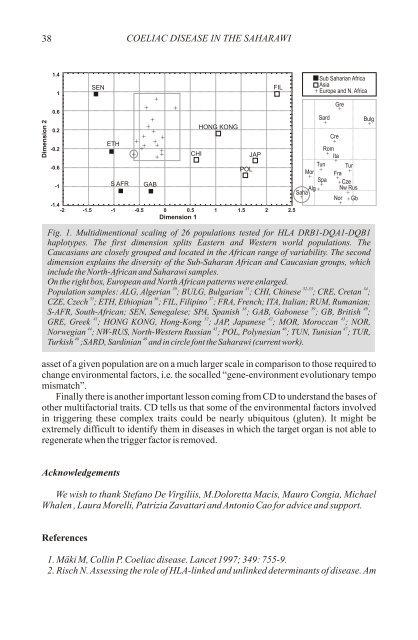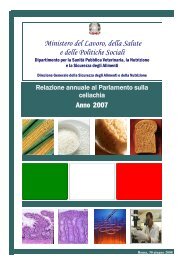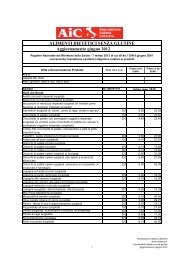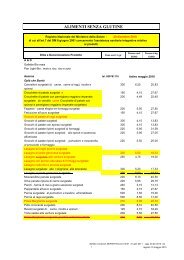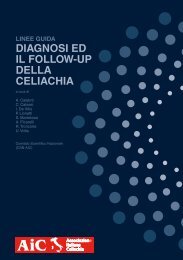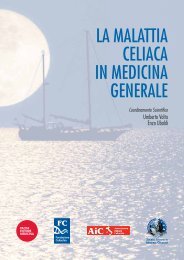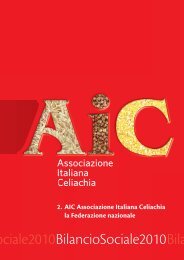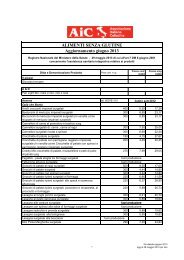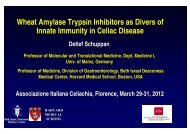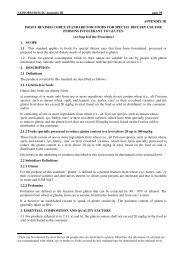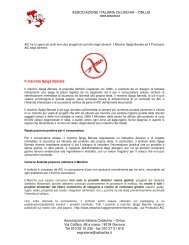primary prevention of coeliac disease - Associazione Italiana ...
primary prevention of coeliac disease - Associazione Italiana ...
primary prevention of coeliac disease - Associazione Italiana ...
You also want an ePaper? Increase the reach of your titles
YUMPU automatically turns print PDFs into web optimized ePapers that Google loves.
38 COELIAC DISEASE IN THE SAHARAWI<br />
Dimension 2<br />
1.4<br />
Sub Saharian Africa<br />
SEN<br />
FIL<br />
Asia<br />
1<br />
+ Europe and N. Africa<br />
+<br />
+<br />
Gre<br />
+<br />
+<br />
0.6<br />
+<br />
Sard<br />
Bulg<br />
+<br />
+<br />
+<br />
HONG KONG<br />
0.2<br />
+<br />
+ + Cre<br />
ETH<br />
+<br />
-0.2<br />
+ ++ ++ +<br />
+ Rom<br />
CHI<br />
JAP<br />
+<br />
+<br />
Ita<br />
+<br />
Tun<br />
-0.6<br />
Tur<br />
POL<br />
+<br />
Mor<br />
+<br />
+<br />
Fra<br />
Spa +<br />
-1<br />
S AFR<br />
+<br />
GAB<br />
+ Cze<br />
Alg+<br />
Nw Rus<br />
Saha<br />
+<br />
+<br />
Nor + Gb<br />
-1.4<br />
+<br />
-2 -1.5 -1 -0.5 0 0.5 1 1.5 2 2.5<br />
Dimension 1<br />
Fig. 1. Multidimentional scaling <strong>of</strong> 26 populations tested for HLA DRB1-DQA1-DQB1<br />
haplotypes. The first dimension splits Eastern and Western world populations. The<br />
Caucasians are closely grouped and located in the African range <strong>of</strong> variability. The second<br />
dimension explains the diversity <strong>of</strong> the Sub-Saharan African and Caucasian groups, which<br />
include the North-African and Saharawi samples.<br />
On the right box, European and North African patterns were enlarged.<br />
30 31 32-33 34<br />
Population samples: ALG, Algerian ; BULG, Bulgarian ; CHI, Chinese ; CRE, Cretan ;<br />
35 36 37<br />
CZE, Czech ; ETH, Ethiopian ; FIL, Filipino ; FRA, French; ITA, Italian; RUM, Rumanian;<br />
38 39 40<br />
S-AFR, South-African; SEN, Senegalese; SPA, Spanish ; GAB, Gabonese ; GB, British ;<br />
41 32 42 43<br />
GRE, Greek ; HONG KONG, Hong-Kong ; JAP, Japanese ; MOR, Moroccan ; NOR,<br />
44 45 46 47<br />
Norwegian ; NW-RUS, North-Western Russian ; POL, Polynesian ; TUN, Tunisian ; TUR,<br />
48 49<br />
Turkish ;SARD, Sardinian and in circle font the Saharawi (current work).<br />
asset <strong>of</strong> a given population are on a much larger scale in comparison to those required to<br />
change environmental factors, i.e. the socalled “gene-environment evolutionary tempo<br />
mismatch”.<br />
Finally there is another important lesson coming from CD to understand the bases <strong>of</strong><br />
other multifactorial traits. CD tells us that some <strong>of</strong> the environmental factors involved<br />
in triggering these complex traits could be nearly ubiquitous (gluten). It might be<br />
extremely difficult to identify them in <strong>disease</strong>s in which the target organ is not able to<br />
regenerate when the trigger factor is removed.<br />
Acknowledgements<br />
We wish to thank Stefano De Virgiliis, M.Doloretta Macis, Mauro Congia, Michael<br />
Whalen , Laura Morelli, Patrizia Zavattari and Antonio Cao for advice and support.<br />
References<br />
1. Mäki M, Collin P. Coeliac <strong>disease</strong>. Lancet 1997; 349: 755-9.<br />
2. Risch N. Assessing the role <strong>of</strong> HLA-linked and unlinked determinants <strong>of</strong> <strong>disease</strong>. Am


